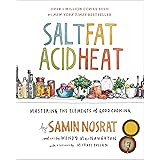Crafting delicious, homemade artisan-style bread might seem like a daunting task, but with the right guidance, it is surprisingly simple and foolproof. As demonstrated in the accompanying video, achieving a beautifully crusty exterior and a soft, airy interior is well within reach for any home baker.
The Essentials of Easy Artisan Bread Baking
To embark on this delightful baking journey, only a few fundamental ingredients are required. These staples come together to create a loaf that rivals those found in professional bakeries. It is often emphasized that simplicity can lead to extraordinary results in baking.
The core ingredients for this artisan-style bread include:
- Three and a half cups of all-purpose flour
- Two teaspoons of kosher salt
- Half a teaspoon of instant dry yeast
- Approximately one and three-quarter cups of warm water
Each component plays a crucial role. All-purpose flour provides the necessary structure, while kosher salt enhances flavor and helps control yeast activity. Instant dry yeast is particularly favored for its convenience, as it can be mixed directly with dry ingredients without prior activation. The water hydrates the flour, allowing gluten to develop, which is essential for the bread’s texture. The temperature of the water is important, as it helps to activate the yeast effectively without being too hot to kill it.
Mixing and Achieving the Perfect Dough Texture
The initial mixing process for this no-knead artisan bread is straightforward. First, the dry ingredients – flour, salt, and yeast – are gently whisked together in a large bowl. This ensures that the yeast and salt are evenly distributed throughout the flour, contributing to a consistent rise and flavor in the finished loaf.
Once the dry ingredients are combined, the warm water is gradually introduced. It is vital to stir the mixture until a shaggy, wet dough forms. A critical tip from the video, and a cornerstone of successful bread baking, is to prioritize the dough’s texture over strict adherence to liquid measurements. If the dough appears too dry after adding the initial amount of water, small splashes of additional warm water should be incorporated until the desired sticky, pliable consistency is achieved. This flexibility accounts for variations in flour absorbency, which can differ based on humidity and brand.
The Importance of Proper Proofing for Homemade Artisan Bread
Proofing is the stage where the yeast truly gets to work, fermenting the sugars in the flour and producing carbon dioxide, which gives the bread its characteristic airy texture. After mixing, the dough is covered and left to proof at room temperature for an extended period, typically five to eight hours. This long, slow fermentation process is key to developing deep, complex flavors in your homemade artisan bread.
During proofing, the dough will visibly expand, often doubling in size, and a network of tiny bubbles will be observed. The duration of proofing can be influenced by ambient temperature; a warmer environment might accelerate the process, while cooler conditions could extend it. Adequate proofing is paramount for a light crumb and a good rise in the oven.
Shaping and Preparing Your Dough for Baking
Once the dough has fully proofed, it is prepared for baking. A clean surface is dusted generously with flour, and hands are also lightly floured to prevent sticking. The dough, which will be quite loose and sticky, is then gently turned out onto the floured surface. The shaping method for this artisan-style bread is minimalist, focusing on creating tension without excessive handling.
The dough is folded in from all four sides, carefully bringing the edges towards the center to form a somewhat round shape. This process helps to build structure and create surface tension, which contributes to a better rise and a more appealing crust. The goal is not a perfectly smooth ball, but rather a compact, folded package that will hold its shape in the oven. This gentle handling ensures that the delicate air pockets developed during proofing are preserved.
Baking to Perfection in a Dutch Oven
The secret to achieving that coveted crispy crust and perfectly baked interior in homemade artisan bread lies in the use of a Dutch oven. Before the dough is placed inside, an empty four or six-quart Dutch oven is preheated in a 425-degree Fahrenheit oven for 30 minutes. This intense preheating ensures that when the dough is added, the Dutch oven acts like a mini steam oven, trapping moisture and promoting maximum oven spring and crust development.
With the Dutch oven screaming hot, the shaped dough is carefully transferred into it. A few slits are often made on the top of the dough with a sharp knife or razor blade (known as scoring). This allows steam to escape in a controlled manner, preventing the crust from tearing haphazardly and adding to the bread’s aesthetic appeal. The Dutch oven, with its lid on, is returned to the oven for an initial bake of 30 minutes. After this period, the lid is removed, and the bread is baked for an additional five to ten minutes to allow the top to brown beautifully and achieve a deep, golden-brown crust. This two-stage baking process is fundamental for artisan bread success.











